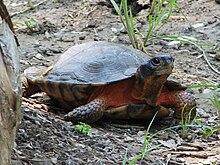Forest brook turtle
| Forest brook turtle | ||||||||||||
|---|---|---|---|---|---|---|---|---|---|---|---|---|

Forest brook turtle ( Glyptemys insculpta ) |
||||||||||||
| Systematics | ||||||||||||
|
||||||||||||
| Scientific name | ||||||||||||
| Glyptemys insculpta | ||||||||||||
| ( Le Conte , 1830) |
The forest brook turtle ( Glyptemys insculpta , Syn .: Clemmys insculpta ) living in eastern North America is a species of the New World pond turtle . Up until a few years ago, like the moorland turtle, it was still included in the genus Clemmys , which today only contains the potted turtle as a monogeneric genus .
The forest brook turtle feeds on berries and fruits as well as animal food and usually overwinters in the bottom mud of a body of water. The animals have a strong sense of direction and show activity at low temperatures, which is unusual for reptiles (it has already been found in the snow).
Appearance
The forest brook turtle looks very robust. It has a flat, longitudinally oval armor that is slightly wider at the rear. The rear edge shields are sawn. It has a pronounced central keel and the eponymous growth rings ( lat. Insculpta, chiseled) of the individual armored back shields are very distinctive. The armor of the back can be colored green-gray, light brown to dark brown. A black or yellowish ray markings can often be seen. The plastron (belly armor) is yellowish in color. Each sign has a dark spot on the lower, outer corner. The upper jaw is notched in front. The head can be grayish to black in color, the neck yellowish to reddish brown. The legs have strong claws, the webbed feet are weak.
The males are up to 13 cm, females up to 23 cm and 600-1000 grams in weight. The males of this species are usually smaller than the females. The latter have a longer tail than the females, thicker at the base. The belly armor of the males is concave inward, that of the females is straight or convex. Slightly outward. The males have very massive heads.
Distribution area and habitat
Glyptemys insculpta is native to northeast North America. Their distribution area extends from southern Canada ( Nova Scotia ) to about Virginia and to the west around the great lakes to Wisconsin . Their habitat are small bodies of water in deciduous and mixed forests as well as lakes, ponds, streams, rivers, swamps and wet meadows. The forest brook turtle is not very closely tied to water. They often stay on land and go on long walks.
They eat plants and fruits as well as earthworms, carrion, slugs and slugs, as well as insects and tadpoles. They overwinter in rotting piles of leaves, holes in the ground, caves under bank embankments or in the bank mud of water.
During the breeding season they show a pronounced courtship behavior. Males are often very aggressive towards each other during this time. The females usually lay their clutch between May and June. Clutches include between four and twelve eggs that are elliptically shaped. In the north of the distribution area the young occasionally only hatch in the next year and thus overwinter in the eggs. Wintering in the nesting pits also occurs.
proof
Individual evidence
- ↑ CR Feldman, JF Parham: Molecular phylogenetics of Emydine turtles: taxonomic revision and the evolution of shell kinesis. In: Molecular Phylogenetics and Evolution. 22, 2002, pp. 388-398.
literature
- Manfred Rogner: Tortoises - biology, keeping, reproduction. Eugen Ulmer, Stuttgart 2008, ISBN 978-3-8001-5440-1 .
- H. Becker: Comments on free-range keeping and breeding of Clemmys insculpta (LE CONTE 1830). In: Salamandra. 31 (1), 1995, pp. 41-48.
- H. Becker: Further remarks on free-range keeping and breeding of Clemmys insculpta (LE CONTE 1830). In: Journal of the AG Tortoise. 6 (3), 1997, pp. 17-30.
- H. Becker: keeping, rearing and continuous offspring up to the F2 generation of the American forest brook turtle, Clemmys insculpta (LE CONTE 1830). In: Elaphe. 10 (2), 2002, pp. 19-30.
- L. Trutnau: Clemmys insculpta (LE CONTE 1830), a remarkable pond turtle from northeastern North America. In: Herpetofauna. 5 (22), 1983, pp. 14-22.
- H. Vetter, M. Daubner: The turtle dictionary on CD . L. Straackmannverlag, 2000, ISBN 3-88675-085-X .
- H. Vetter: Turtles of the World. Volume 2: North America. Chimaira Buchhandlungsgesellschaft, 2004, ISBN 3-930612-57-7 .
Web links
Web links
- Glyptemys insculpta in The Reptile Database
- Glyptemys insculpta inthe IUCN 2013 Red List of Threatened Species . Posted by: van Dijk, PP & Harding, J., 2011. Retrieved September 10, 2013.
